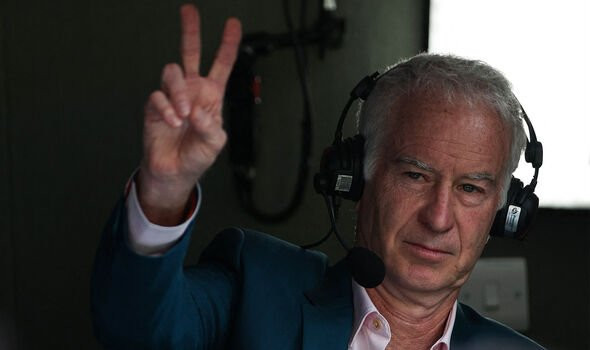John McEnroe, a name synonymous with tennis brilliance and on-court volatility, is revisiting his tumultuous past in a candid new documentary. The tennis legend, who once held the world No. 1 ranking in both singles and doubles, retired from professional play around 1999 but remains a prominent figure as a commentator for networks like ESPN and the BBC. Known for his outspoken nature, McEnroe recently opened up about his infamous “you cannot be serious” outbursts and the surprising toll they took on his well-being.
In a revealing interview preceding the documentary’s release, McEnroe drew parallels between his past behavior and that of contemporary players like Nick Kyrgios. “You sort of feed into this villain thing, maybe unbeknown to yourself, and then it becomes this out-of-control monster,” McEnroe confessed. This reflection highlights a crucial aspect of his career: the unintended consequences of his on-court persona.
 John McEnroe
John McEnroe
Alt text: John McEnroe portrait during a tennis match, expressing frustration, highlighting his career-long struggle with anger management.
He elaborated on the public perception that solidified around his tantrums. “People started to recognise me — ‘Are you that brat guy?’ — and it completely changed my life. I was, like, ‘They don’t understand me, I’m a nice guy.’ But of course I wasn’t real nice on the court at times.” This quote reveals McEnroe’s internal conflict – the disparity between his self-image and the public’s perception of him as a volatile figure. This disconnect became a defining element of his early career narrative.
McEnroe described his on-court outbursts as a form of “addiction,” a cycle he sought professional help to break. He likened it to cigarette smoking, saying, “I think I would compare it to someone who’s a cigarette smoker. I mean the addiction becomes — you don’t like it. I mean you might convince yourself, at one stage, maybe some of these kids, ‘Oh I’ll never get addicted to cigarette smoke. It’s just something I’ll do briefly. It looks cool.'” This analogy powerfully illustrates the compulsive nature of his anger and the difficulty in overcoming such ingrained behaviors, even when recognized as detrimental.
He acknowledged the initial perceived benefits of his confrontational style. “For a while as far as what I was doing on the court, when I started questioning line calls and going a bit crazy, I did feel most of the time it helped me.” However, he admitted the downsides, “It did hurt me in a couple of big matches. But for the most part, that’s what I brought to the table — that will, the drive.” This highlights the double-edged sword of his intensity – it fueled his competitive drive but also hindered him at critical moments, demonstrating the complex relationship between emotion and performance in high-pressure sports.
The turning point towards self-reflection came with personal challenges, including court-mandated anger management counseling following his divorce from Tatum O’Neal. “I’ve had plenty of therapists,” he stated, “Some of them court-appointed.” This candid admission underscores the real-world consequences of his behavior and the external pressures that pushed him towards seeking help and personal growth.
McEnroe’s journey of self-discovery extends to his personal relationships and understanding his own emotional makeup. He mentioned the therapeutic nature of his 2022 documentary, noting it helped him process unresolved grief related to his father’s passing in 2017, specifically the lack of a proper goodbye. This reveals a deeper emotional layer beneath the surface of the fiery tennis star, linking his personal history to his public persona.
Adding another layer to the narrative, McEnroe’s wife, Patty Smyth, offered a potential perspective on his behavior, suggesting he might be on the autism spectrum. She theorized that his exceptional focus in tennis, coupled with his frustration when things deviate from his plan, aligns with characteristics sometimes associated with autism.
 John McEnroe
John McEnroe
Alt text: John McEnroe and Patty Smyth, his wife, pictured together, reflecting the personal insights she brought into understanding his behavior and potential autism spectrum traits.
McEnroe’s response to this suggestion was nuanced: “It’s safe to say that I’m probably somewhere around there,” neither confirming nor denying an autism diagnosis. This ambiguity opens up a broader conversation about neurodiversity and how different ways of processing the world can manifest, even in high-achieving individuals.
While acknowledging he has “mellowed” with age, McEnroe recognizes his enduring tendency to “rub people up the wrong way.” He credits his wife, Patty Smyth, for helping him evolve. This ongoing self-awareness and commitment to personal growth demonstrate a significant shift from his earlier, more volatile years.
Although McEnroe hasn’t explicitly addressed autism further, the National Autistic Society provides valuable context. They note that individuals with autism can experience heightened frustration and anger. Children with social communication challenges and repetitive behaviors are more susceptible to emotional regulation difficulties, potentially leading to meltdowns or shutdowns. Understanding these patterns provides a framework for interpreting McEnroe’s past struggles with emotional control.
The National Autistic Society differentiates between meltdowns and shutdowns as responses to overwhelming situations. Meltdowns are characterized by outward expressions of distress, like shouting or physical actions, often mistaken for tantrums. Shutdowns, while less outwardly dramatic, represent an equally debilitating state of being overwhelmed, often leading to passivity and difficulty in reacting or processing emotions.
Common signs of autism in adults, as outlined by the National Autistic Society, include challenges in understanding others’ feelings, social anxiety, difficulty making friends, blunt communication, struggles expressing emotions, literal interpretations, and rigid routines. These points provide a broader understanding of traits that may resonate with McEnroe’s experiences and personality, both on and off the court.
For those supporting individuals, whether children or adults, who may be on the autism spectrum or struggle with anger management, the National Autism Society recommends clear communication, structured environments, designated time-out spaces, and offering alternative coping mechanisms. These strategies emphasize creating supportive and understanding environments to help individuals navigate emotional challenges effectively.
